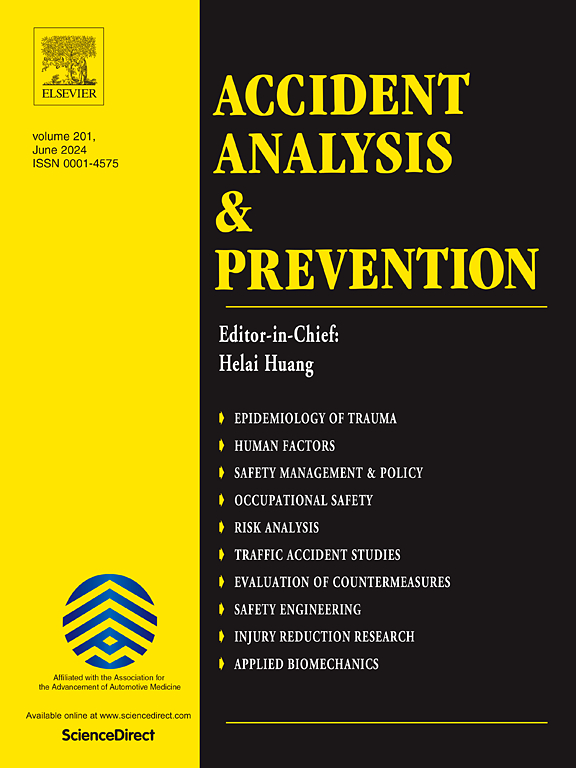Impact of jaywalking on pedestrian interaction behavior: A multiagent Markov Game-based analysis
IF 6.2
1区 工程技术
Q1 ERGONOMICS
引用次数: 0
Abstract
Jaywalking behavior represents a major safety concern especially in traffic environments with intense pedestrian activity. Despite the influence of this behavior on crash risk given that drivers have unexpected interactions with pedestrians and must take additional evasive actions, limited pedestrian models have accounted for jaywalking behavior. This research uses Multiagent Adversarial Inverse Reinforcement Learning (MAAIRL) within a Markov game framework to model road user behavior in jaywalking scenarios at signalized intersections, offering a detailed representation of the dynamic and complex decision-making strategies of pedestrians and drivers in these situations. This approach enables obtaining reward functions that can be used to make inferences about their behaviors and optimal policies that represent the best sequences of decisions, which can be used in developing microsimulation models. Results show that jaywalking pedestrians exhibited erratic movements, with higher acceleration rates and unpredictable paths. In contrast, non-jaywalking pedestrians showed more predictable behavior with smaller variations in their paths and greater distances from vehicles while crossing. Additionally, jaywalking scenarios led to smaller time-to-collision (TTC) and post-encroachment time (PET) values, reduced minimum distances, and faster pedestrian movements compared to non-jaywalking scenarios, which shows the increased crash risks associated with jaywalking. Finally, the MAAIRL model was able to adequately learn the behaviors associated with both non-jaywalking and jaywalking pedestrians. This shows the potential of this framework to model complex real-world scenarios. These findings underscore the importance of improving pedestrian simulation models to take into account the distinct behavioral patterns associated with jaywalking, and such advancements can facilitate a more comprehensive examination of the safety impacts in busy pedestrian environments.
乱穿马路对行人交互行为的影响:基于多智能体马尔可夫博弈的分析
乱穿马路的行为是一个主要的安全问题,特别是在行人活动密集的交通环境中。尽管这种行为对碰撞风险有影响,因为司机与行人有意想不到的互动,必须采取额外的规避行动,有限的行人模型已经解释了乱穿马路的行为。本研究使用马尔可夫博弈框架中的多智能体对抗逆强化学习(MAAIRL)来模拟信号交叉口乱穿马路场景中的道路用户行为,详细描述了行人和驾驶员在这些情况下的动态和复杂决策策略。这种方法可以获得奖励函数,可以用来推断他们的行为和代表最佳决策序列的最优策略,这可以用于开发微观模拟模型。结果表明,乱穿马路的行人表现出不稳定的行为,加速度更高,路径不可预测。相比之下,不乱穿马路的行人表现出更可预测的行为,他们的路径变化更小,在过马路时与车辆的距离更远。此外,与不乱穿马路的情况相比,乱穿马路导致碰撞时间(TTC)和侵犯后时间(PET)值更小,最小距离更短,行人运动速度更快,这表明乱穿马路增加了碰撞风险。最后,MAAIRL模型能够充分学习非乱穿马路和乱穿马路的行人的相关行为。这显示了该框架为复杂的现实场景建模的潜力。这些发现强调了改进行人模拟模型以考虑与乱穿马路相关的不同行为模式的重要性,这样的进步可以促进对繁忙行人环境中安全影响的更全面检查。
本文章由计算机程序翻译,如有差异,请以英文原文为准。
求助全文
约1分钟内获得全文
求助全文
来源期刊

Accident; analysis and prevention
Multiple-
CiteScore
11.90
自引率
16.90%
发文量
264
审稿时长
48 days
期刊介绍:
Accident Analysis & Prevention provides wide coverage of the general areas relating to accidental injury and damage, including the pre-injury and immediate post-injury phases. Published papers deal with medical, legal, economic, educational, behavioral, theoretical or empirical aspects of transportation accidents, as well as with accidents at other sites. Selected topics within the scope of the Journal may include: studies of human, environmental and vehicular factors influencing the occurrence, type and severity of accidents and injury; the design, implementation and evaluation of countermeasures; biomechanics of impact and human tolerance limits to injury; modelling and statistical analysis of accident data; policy, planning and decision-making in safety.
 求助内容:
求助内容: 应助结果提醒方式:
应助结果提醒方式:


